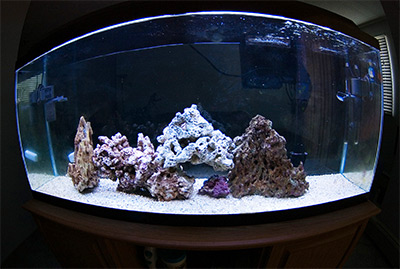Question
The fish store dealer who’s helping me through the setup of my first saltwater aquarium told me I need to give the tank time to cycle before I put any fish or corals in it. As of right now, the tank has been operating for about a month. Is that long enough for it to get cycled completely? Is it safe to add live rock yet? My kids are anxious to see some critters in there! – Submitted by Josh P.
Answer
Josh, I think you might be functioning under a classic misconception harbored by many a hobby newcomer—i.e., that cycling a new aquarium is simply a matter of setting up the tank and then waiting for some predetermined amount of time to pass before adding livestock.
While cycling takes time and is carried out by certain strains of bacteria, it’s not an entirely passive process from the hobbyist’s standpoint. In other words, you can let your tank run from now until there’s ice hockey in Hades, and it still won’t be suitable for supporting marine life unless you take certain steps to ensure appropriate conditions are present.
Remember, for cycling to occur (and, thus, for an aquarium system to have an adequate biological filter in place), the following elements must be present: colonies of aerobic nitrifying bacteria, oxygenated water, substrate for the bacteria to colonize, and a source of ammonia.
Nitrifying bacteria are ubiquitous and will find their way into the tank with no help from you, but the population can be jumpstarted in different ways, for example by adding live rock and/or live sand, borrowing filter media or some “seeded” substrate from an established system, adding one of the various proprietary nitrifying bacteria cultures, etc.
Oxygenated water is also fairly easy enough to provide—via surface agitation and robust circulation, protein skimming, plumbing the system so water flows vigorously down into a sump, and so forth.
As far as suitable substrate is concerned, nitrifying bacteria will colonize any available surface in the tank, but to ensure the population can expand to keep pace with an increasing bioload (as you gradually introduce livestock), the tank should be aquascaped with a good amount of porous rock. A bed of sand or gravel will also promote the colonization of nitrifying bacteria (at least close to the surface of the bed), but not all hobbyists favor using this type of substrate and it’s certainly not essential to include one if you have adequate rockwork in the tank.
Last but certainly not least, no cycling can begin without ammonia. But please don’t add damsels or any other form of marine life in order to provide it. Instead, you can introduce ammonia by, for example, adding fish food to the tank and allowing it to decompose, dosing pure household ammonia, or, my much-preferred method, adding live rock. (So, in answer to part of your question, yes, it is safe to add live rock to your tank now.)
What does live rock have to do with ammonia? Well, any time you add live rock to a system—even pre-cured pieces—there is some degree of die-off of encrusting organisms that takes place. That die-off produces enough ammonia to kickstart the cycle—not to mention the rocks provide the perfect substrate for bacterial colonization and, in fact, come equipped with the nitrifying bacteria themselves. So three out of the four elements necessary for cycling are already present in live rock.
After you’ve settled on a way to introduce ammonia, you simply monitor the cycling process with ammonia, nitrite, and nitrate test kits. The system can be considered cycled once the ammonia and nitrite levels have both spiked and dropped to zero. At that point, you can begin to add livestock very slowly and incrementally. Don’t rush it or you’ll overwhelm your tenuous biofilter and cause a deadly ammonia spike. Be prepared to do major water changes if such is observed.



